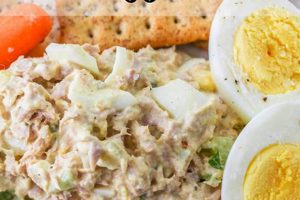A classic Caesar salad typically includes raw egg yolks in its dressing, contributing to a rich, creamy texture and distinct flavor. However, omitting the eggs creates a vegan-friendly and safer alternative, eliminating concerns about salmonella. This variation still retains the core elements of a Caesar: crisp romaine lettuce, crunchy croutons, parmesan cheese, and a tangy, savory dressing. A typical egg-free version utilizes ingredients like lemon juice, garlic, Dijon mustard, olive oil, and Worcestershire sauce to achieve a similar flavor profile.
The rising popularity of plant-based diets and increased awareness of food safety have contributed to the demand for eggless Caesar dressings. This adaptation allows individuals with dietary restrictions or concerns about raw eggs to enjoy a beloved classic. While the traditional recipe’s origins are debated, the eggless version represents a modern take, aligning with contemporary dietary needs and preferences. This approach offers a broader accessibility to the dish while potentially appealing to those seeking lighter, less cholesterol-rich options.
The following sections will delve deeper into creating a delicious egg-free Caesar dressing, exploring variations, ingredient substitutions, and tips for achieving optimal flavor and texture. Guidance on crouton preparation and lettuce selection will also be provided, ensuring a comprehensive understanding of constructing a satisfying and safe eggless Caesar salad.
Tips for Crafting an Excellent Eggless Caesar Salad
Achieving a flavorful and satisfying Caesar salad without eggs requires attention to detail and a few key techniques. The following tips offer guidance on optimizing the dressing, croutons, and overall salad construction.
Tip 1: Emulsify the Dressing Thoroughly: A stable emulsion is crucial for a creamy, cohesive dressing. Whisk the ingredients vigorously or use a blender to create a smooth, well-combined mixture. Slow, gradual addition of the oil while whisking helps achieve a proper emulsion.
Tip 2: Balance Acidity and Umami: Lemon juice provides necessary acidity, while ingredients like Worcestershire sauce and Dijon mustard contribute umami. Adjust these components to achieve a balanced, savory flavor profile.
Tip 3: Enhance Flavor with Nutritional Yeast: Nutritional yeast offers a cheesy, slightly nutty flavor that complements the other ingredients and adds depth to the dressing. It also provides a nutritional boost.
Tip 4: Optimize Crouton Texture: Homemade croutons offer superior texture and flavor. Use day-old bread, cut into uniform sizes, and toss with olive oil, garlic powder, and salt before baking until golden brown and crisp.
Tip 5: Select and Prepare the Lettuce: Crisp romaine lettuce is traditional. Wash and dry the leaves thoroughly before tearing into bite-sized pieces. Avoid overdressing to maintain the lettuce’s crispness.
Tip 6: Consider Flavorful Additions: Enhance the salad with additions such as chopped capers, roasted red peppers, or grilled chicken or chickpeas for added protein and flavor complexity.
Tip 7: Chill Before Serving: Allowing the dressing to chill for a short time enhances the flavors and provides a refreshing element to the salad.
By following these tips, one can create an egg-free Caesar salad that rivals the classic in terms of flavor, texture, and satisfaction. Attention to detail in each step ensures a truly enjoyable culinary experience.
The concluding section will summarize the key elements discussed and offer final recommendations for preparing an exceptional eggless Caesar salad.
1. Vegan-Friendly Dressing
A vegan-friendly dressing is fundamental to a Caesar salad recipe without eggs. It eliminates the traditional use of raw egg yolks, addressing dietary restrictions and food safety concerns while offering a plant-based alternative.
- Emulsification
Traditional Caesar dressings rely on egg yolks as an emulsifier, binding oil and water-based ingredients. Vegan versions achieve emulsification through alternative methods. Pureed white beans, silken tofu, or avocado can create a creamy texture and stabilize the dressing. Successfully emulsifying the dressing prevents separation and ensures a consistent coating on the salad components.
- Flavor Profile
Recreating the characteristic tangy, umami flavor of Caesar dressing without eggs requires careful consideration of ingredients. Lemon juice, Dijon mustard, Worcestershire sauce (ensure vegan-friendly), garlic, and nutritional yeast contribute to the desired flavor profile. Nutritional yeast provides a cheesy note, while capers can introduce a briny element. Balancing these components is essential for an authentic Caesar taste.
- Nutritional Considerations
Egg yolks contribute fat and cholesterol to traditional Caesar dressings. Vegan alternatives offer different nutritional profiles. Plant-based emulsifiers like avocado provide healthy fats, while nutritional yeast adds B vitamins. Ingredient choices impact the overall nutritional value of the salad. Opting for low-sodium ingredients or adjusting quantities can further align the dressing with specific dietary needs.
- Ingredient Sourcing
Careful selection of ingredients is crucial for a truly vegan Caesar dressing. Worcestershire sauce, often containing anchovies, requires a vegan alternative. Ensuring all components are plant-derived maintains the integrity of the vegan approach. Reading labels and understanding ingredient origins is vital for successful vegan cooking.
By understanding the elements of a vegan-friendly dressing, one can successfully adapt a Caesar salad recipe to meet dietary needs and preferences without sacrificing flavor or texture. This approach broadens the accessibility of this classic dish, offering a satisfying and inclusive culinary experience.
2. Crisp Romaine Lettuce
Crisp romaine lettuce forms the foundation of a successful Caesar salad, regardless of the presence or absence of eggs in the dressing. Its structural integrity and refreshing flavor are essential for balancing the richness of the dressing and the contrasting textures of croutons and other additions. The quality and preparation of the romaine significantly influence the overall dining experience.
- Textural Contrast
The crispness of romaine lettuce provides a crucial textural counterpoint to the creamy dressing, whether traditional or egg-free. The satisfying crunch offers a refreshing contrast to the softer elements of the salad. This interplay of textures elevates the dish beyond a simple combination of ingredients, creating a more dynamic and enjoyable sensory experience.
- Flavor Compatibility
Romaine’s subtly sweet and slightly bitter flavor profile complements the savory notes of the Caesar dressing. Its neutral character allows the other flavors to shine without being overpowering. This balance ensures that the romaine contributes to the overall flavor harmony without dominating the palate. The slight bitterness also cuts through the richness of the dressing, providing a refreshing counterpoint.
- Structural Integrity
The sturdy structure of romaine lettuce allows it to hold the dressing without becoming soggy. This is particularly important in an eggless Caesar salad, where the dressing might lack the emulsifying properties of egg yolks. The robust leaves maintain their shape and texture even when coated with dressing, ensuring a pleasant eating experience. Properly dried leaves are essential for preventing the dressing from becoming diluted.
- Preparation and Presentation
Proper preparation of the romaine enhances both the flavor and presentation of the salad. Washing and thoroughly drying the leaves prevents dilution of the dressing and maintains crispness. Tearing the leaves into bite-sized pieces, rather than chopping, creates a more appealing visual texture and prevents bruising. These seemingly small details significantly impact the final dish’s overall quality and enjoyment.
The choice and preparation of romaine lettuce are integral to a successful Caesar salad, particularly when crafting an egg-free version. Its textural contribution, flavor compatibility, and structural integrity are essential for balancing the other components and creating a satisfying culinary experience. By understanding these aspects, one can elevate a simple salad to a sophisticated and flavorful dish.
3. Flavorful Croutons
Flavorful croutons contribute significantly to the overall sensory experience of a Caesar salad, especially in variations without eggs. The absence of egg yolk in the dressing can sometimes lead to a perceived lack of richness or depth of flavor. Well-seasoned croutons compensate for this potential deficiency by introducing a savory, crunchy element that complements the other components. Their presence provides textural contrast and amplifies the umami notes typically associated with a classic Caesar. For instance, croutons seasoned with garlic powder, onion powder, and a blend of herbs enhance the overall savory profile of the salad, counterbalancing the lighter, brighter notes of a vinaigrette-style, egg-free dressing. This interplay of textures and flavors creates a more complex and satisfying culinary experience.
The type of bread used for croutons also plays a crucial role. A sturdy, day-old loaf, such as sourdough or ciabatta, yields croutons with a desirable texturecrisp on the exterior and slightly chewy on the interior. Proper toasting methods, whether oven-baked or pan-fried, further enhance the flavor and texture. For example, oven-baked croutons tossed in olive oil and seasoned with herbs develop a deep, toasted flavor that enhances the salad. Pan-fried croutons offer a quicker method, achieving a similar crispness and allowing for greater control over browning. Furthermore, the size and shape of croutons influence their textural impact. Smaller, bite-sized pieces offer a more consistent crunch in each bite, while larger, irregular shapes provide a more rustic aesthetic and varied textural experience.
In the context of a Caesar salad without eggs, croutons become more than just a garnish; they function as an essential component that elevates the overall flavor profile and textural complexity. Careful consideration of bread selection, seasoning, and toasting methods ensures that the croutons contribute meaningfully to the salad, compensating for the absence of egg yolk and creating a balanced and satisfying dish. This attention to detail transforms the croutons from a simple addition to a key element that defines the success of an eggless Caesar salad.
4. Tangy, Umami Dressing
A tangy, umami dressing is paramount to replicating the characteristic flavor profile of a traditional Caesar salad in a recipe that omits eggs. The absence of raw egg yolks necessitates a careful balancing act of other ingredients to achieve the desired depth and complexity. Umami, often described as a savory, “fifth taste,” is traditionally provided by the egg yolk in a classic Caesar. In an eggless version, this flavor must be derived from other sources. Ingredients like Worcestershire sauce (ensure a vegan version is used), miso paste, or nutritional yeast can contribute umami notes. The tanginess, typically imparted by lemon juice, vinegar, or a combination of both, balances the richness of the umami and other savory elements. This careful interplay of tangy and umami notes ensures the dressing doesn’t become overly rich or one-dimensional. For example, a dressing featuring a blend of lemon juice, Dijon mustard, nutritional yeast, and a touch of vegan Worcestershire sauce can effectively capture the essence of a Caesar dressing without relying on eggs.
The practical significance of understanding this balance extends beyond simply replicating a familiar flavor. A well-executed tangy, umami dressing elevates the entire salad, compensating for the absence of egg yolks. It adds depth and complexity, ensuring that the salad is not perceived as lacking in richness or flavor. Furthermore, the tanginess of the dressing helps cut through the richness of other ingredients, such as croutons or added proteins like grilled chicken or chickpeas, creating a more balanced and refreshing overall experience. The balance also plays a crucial role in how the dressing interacts with the romaine lettuce. A dressing that is overly rich or lacks acidity might make the lettuce wilt or become soggy, whereas a well-balanced dressing will coat the leaves evenly without compromising their crispness. This ensures a pleasant textural experience, which is essential for a successful salad.
In conclusion, achieving a harmonious balance of tangy and umami flavors in the dressing is crucial for a successful eggless Caesar salad. It not only replicates the desired flavor profile but also contributes to the overall textural experience and ensures that the salad remains a satisfying and enjoyable dish, even without the traditional inclusion of raw egg yolks. The careful selection and balancing of ingredients, such as vegan Worcestershire sauce, nutritional yeast, and lemon juice, are key to achieving this outcome and demonstrating a thorough understanding of flavor principles in plant-based cuisine.
5. Safe Ingredient Choices
Safe ingredient choices are paramount when preparing a Caesar salad without eggs, primarily due to the elimination of a key ingredient that traditionally carries food safety risks. Raw egg yolks, a hallmark of the classic Caesar dressing, pose a potential risk of salmonella contamination. Omitting eggs inherently enhances the safety profile of the salad, but careful consideration of other ingredients remains crucial. For example, ensuring that any Worcestershire sauce used is a vegan variety eliminates the risk of hidden anchovies, catering to dietary restrictions and potential fish allergies. Similarly, selecting fresh, properly washed, and stored produce minimizes the risk of bacterial contamination from the lettuce and other vegetables.
Beyond the immediate safety benefits, opting for safe ingredient choices contributes to broader health considerations. Using low-sodium versions of ingredients like Worcestershire sauce or opting for freshly grated Parmesan cheese instead of pre-grated varieties with added preservatives aligns with dietary guidelines for reducing sodium intake. Furthermore, selecting high-quality olive oil contributes beneficial monounsaturated fats. Homemade croutons, prepared with whole-grain bread, offer more nutritional value than commercially produced options, often containing excessive saturated fats and preservatives. These conscious ingredient choices transform the eggless Caesar salad from simply a safe option to a health-conscious one. For individuals with specific dietary requirements, such as gluten intolerance, using gluten-free bread for croutons or ensuring all other ingredients are certified gluten-free further exemplifies the practical significance of safe ingredient choices.
In summary, safe ingredient choices in an eggless Caesar salad extend beyond mitigating the inherent risks associated with raw eggs. They encompass a holistic approach to food preparation, addressing dietary restrictions, minimizing exposure to harmful bacteria and excessive preservatives, and maximizing nutritional value. This approach aligns with the growing awareness of the interconnectedness between food choices, personal health, and overall well-being. By prioritizing safe and mindful ingredient selection, individuals can enjoy a delicious and nutritious Caesar salad without compromising flavor or safety.
Frequently Asked Questions
This section addresses common inquiries regarding Caesar salad recipes without eggs, offering clarity on preparation methods, ingredient substitutions, and potential challenges.
Question 1: What can replace raw egg yolks as an emulsifier in a Caesar dressing?
Several alternatives effectively emulsify egg-free Caesar dressings. Silken tofu, avocado, or pureed white beans create a creamy consistency and bind the oil and water-based ingredients, preventing separation.
Question 2: How can the characteristic umami flavor of a Caesar dressing be achieved without eggs?
Ingredients like nutritional yeast, vegan Worcestershire sauce, or a small amount of miso paste contribute umami notes to the dressing, compensating for the absence of egg yolks. Careful balancing of these ingredients with acidic components like lemon juice is essential.
Question 3: Are there specific safety concerns to consider when preparing a Caesar salad without eggs?
While omitting eggs eliminates the risk of salmonella, general food safety practices remain important. Thoroughly washing and drying lettuce, using a vegan Worcestershire sauce, and proper storage of ingredients are crucial for preventing bacterial contamination.
Question 4: What type of bread is best for making croutons for a Caesar salad?
A sturdy, day-old bread like sourdough or ciabatta works well for croutons. These breads hold their shape when toasted and offer a desirable textural contrast to the salad’s other components.
Question 5: Can a Caesar salad without eggs be as flavorful as the traditional version?
Absolutely. Careful selection and balancing of ingredients in the dressing, along with proper preparation of the croutons and lettuce, can result in an egg-free Caesar salad that rivals the classic in terms of flavor and satisfaction.
Question 6: Are there any nutritional advantages to omitting eggs in a Caesar salad?
Removing eggs reduces the cholesterol and saturated fat content of the salad. Using plant-based emulsifiers and other healthful ingredients can further enhance the nutritional profile.
Addressing these common questions provides a foundation for confidently preparing a delicious and safe Caesar salad without eggs. A thorough understanding of ingredient substitutions and preparation techniques ensures a satisfying culinary experience.
The subsequent section will offer a sample recipe for an egg-free Caesar salad, demonstrating the practical application of the principles discussed throughout this article.
Caesar Salad Recipe Without Eggs
Exploration of Caesar salad recipes without eggs reveals a versatile and adaptable culinary landscape. Eliminating raw egg yolks enhances safety and inclusivity, catering to dietary restrictions and preferences without compromising flavor. Achieving a balanced, tangy, and umami-rich dressing requires careful selection of plant-based ingredients and emulsifying techniques. Crisp romaine lettuce, a cornerstone of the dish, provides essential textural contrast, while flavorful croutons contribute depth and complexity. Mindful ingredient choices further enhance nutritional value and align with contemporary health-conscious approaches. Addressing common inquiries regarding ingredient substitutions and preparation methods empowers culinary exploration and ensures a satisfying outcome.
The eggless Caesar salad signifies more than a simple adaptation; it represents a culinary evolution. This variation embraces inclusivity, promotes mindful ingredient choices, and underscores the dynamic nature of culinary traditions. Further exploration of plant-based cuisine promises continued innovation and expansion of classic dishes, enriching the gastronomic experience for a wider audience.






